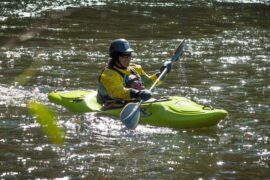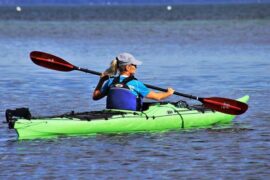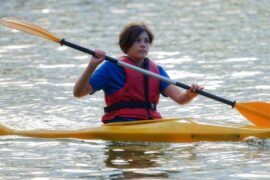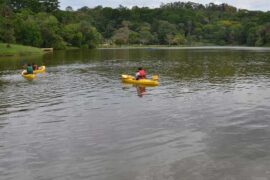The weekend and holidays are when most people unwind with their favorite activity. Most of us work indoors during the week, and during the weekend, we want to be outdoors to breathe in the fresh air and enjoy some sun.
Outdoor events are an excellent choice because you get to do something fun while keeping fit, and one of the best activities is kayaking.
As a beginner, you may be curious about how long you can kayak in a day. This question is best answered in the article below because many factors contribute to the distance you can cover.
-
Health
More people are gravitating towards kayaking because of the many health benefits you stand to gain.
When you start to kayak regularly, you will notice a few physical changes such as lean arms, a more defined core, and increased leg muscles. You also reap other benefits, such as more normal blood pressure, and it serves as excellent cardio.
However, the distance you can cover when kayaking is still heavily dependent on your health. This is partly due to the heavy paddling you will be doing as you cross the waters.
You will be fighting the resistance with water to propel yourself; thus, people with more upper body strength are more likely to cover more distance.
This does not mean people on the heavier side cannot kayak because many kayaks fit different body types and weights.
When kayaking, it is best to alert your instructor of any preexisting health conditions that may be exasperated.
The instructor will also be able to advise on how much strain is too much for your body to handle and how far is enough for you to enjoy and reap the health benefits without causing injury.
It is best to take regular breaks, stretch, and then return to it. These breaks help you build tolerance which enables you to endure longer distances.
As much as you want to kayak the whole day, it is best to listen to your body, and when you feel like it is time to stop, you should do so immediately.
-
Weather Conditions
One of the lessons you will learn when you start kayaking is how to judge the weather appropriately. These lessons are essential because most beginners ignore warning signs of weather changes.
In some cases, the rower is vehemently focused on achieving the desired distance that they completely ignore adverse weather.
Heavy rains and thunderstorms make it significantly harder to go long distances. It is also dangerous because you could get electrocuted kayaking if there is lightning. Alternatively, you can paddle a longer distance when it is warm and sunny.
Winds and waves affect the distance covered both by beginners and experienced kayakers. It would be best if you appreciated that stronger winds and tides would create more resistance, reducing the distance you can kayak.
Raging waves will keep changing the kayak’s direction, and since following a straight line helps you cover more ground, the contrary will affect the distance covered.
The water temperatures will have a hand in how far you can kayak. Air and water temperatures differ because water tends to be colder. This will increase the risk of hypothermia if you fall into the icy waters.
Hypothermia and cold shock expose you to health problems such as difficulty in breathing, mental ill health, and changes in blood pressure after 30 to 60 minutes of exposure.
People are advised not to veer off too far so that a rescue team can get to them faster in an emergency because prolonged exposure to cold shock can lead to death.
You should note that cold waters can prevail even during summer because water takes longer to warm up.
If you want to kayak a greater distance, choose a day when the winds are calm, ideally at 15 knots and below.
-
Type of Kayak
Kayaks come in different shapes and sizes, affecting the distance the kayaker will cover.
The most common types include touring, fishing, tandem, and modular kayaks where you can sit in or sit on top.
The materials used to make kayaks, such as thermoform, wood, graphite, and rotomold, also affect how far you can go.
Both these factors will affect the distance to be covered and should be considered before you venture off.
The kayak’s design also determines how many people it can accommodate at a given time, which increases rowing power and the distance covered.
Certain types of kayaks will help you cover more such as tandem kayaks. These kayaks go longer because their long bodies make for a longer waterline length, thus maximizing speed.
There are more structured estimations for the distance you can cover daily. If you are paddling in waters that are 9 feet deep at a speed of 4.0 knots, you will likely cover 4.6 miles per hour.
This chart increased by 0.3 miles per hour for each 1-foot increase in water depth and 0.2 knots increase in speed. This means that solo, experienced kayakers can cover up to 20 miles daily.
-
Other Factors
Since kayaking is a leisure activity, you will find that some people will come with their refreshments, and in most cases, they are alcohol.
Alcohol impairs your judgment, affecting your ability to paddle stronger and faster, thus covering less distance. There is also an increased chance of capsizing and drowning when inebriated.
Experience plays a vital role in the type of waters you can paddle and the distance you can comfortably cover.
There are many cases of kayakers who have overestimated their abilities and ended up in a vicarious situation.
Your skills will determine how far out you can safely go and when in doubt, it is best to stay near the shore, especially as a beginner.
The types of waters you are kayaking on will determine how far you can go. For instance, low-head dams are dangerous, and it is recommended that you get back to shore if you encounter one.
A kayak is a safe vessel, but it may not be the case if you paddle in shark-infested waters. There are waters where you are more exposed to the risk of a shark attack at a certain distance, limiting how far you can kayak.
The above factors will significantly impact the distance you can cover while kayaking. As time goes by, you will be able to overcome some of them and improve your reach.




